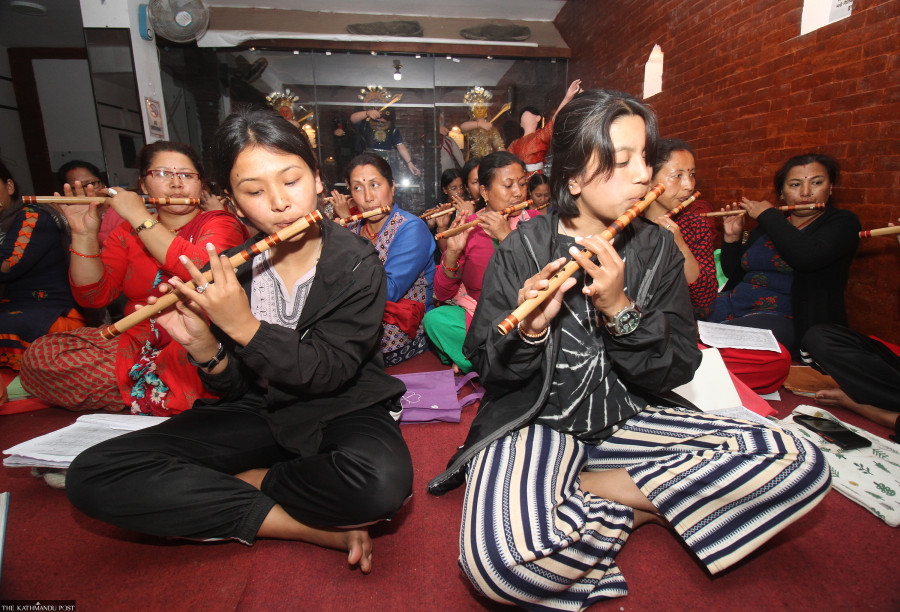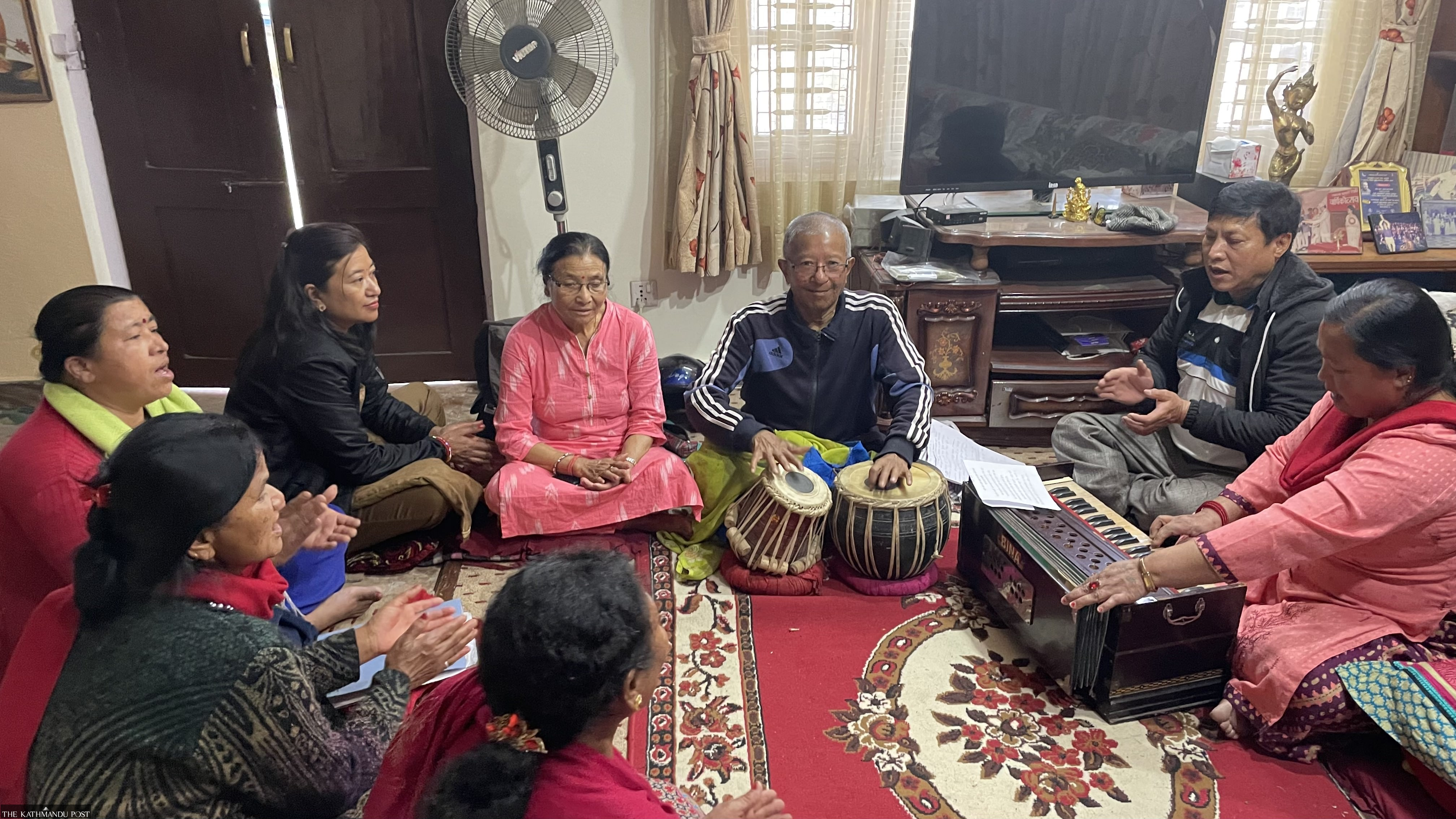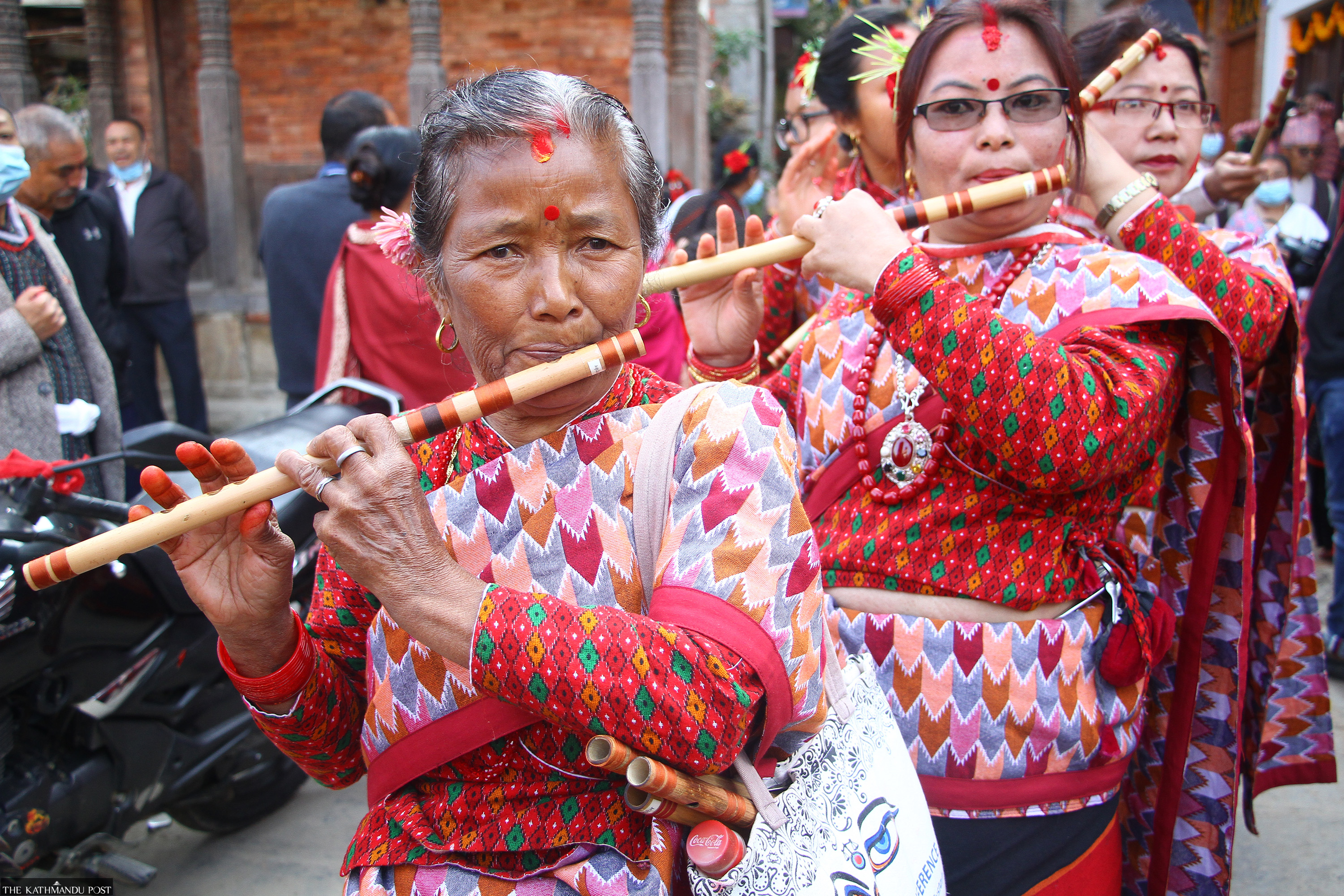Culture & Lifestyle
Keeping alive Newa musical art forms
Once barred from participating in traditional Newa musical art forms, women are now playing a key role in preserving the heritage.
Srizu Bajracharya
Five colourful masked deities of Kirtipur watch as 47-year-old Geeta Maharjan coyly plays the song ‘Likka Woya Jita Dhala Won’ on her flute at Tahnani Dapha Khala:, Kirtipur.
“It’s a popular Nepalbhasa song, and I am still trying to master it. But I think I sound better when I play with my music group. When I play individually, you will notice that I miss rhythms,” says Maharjan, who is part of an ensemble that performs dapha, an age-old devotional Newa music.
Maharjan is among the first women to be part of Kirtipur's Tahnani Dapha Khala:. And today, women like her are playing an integral role in sustaining the art form, and their participation has also brought about a renewed sense of excitement and energy to the music tradition.
Until the early 90s, however, the larger Newa folk/traditional music (under which dapha falls) were exclusive to men. But faced with a lack of interest in the traditional Newa musicals art forms among the younger generation of the time and concern over such art forms going extinct, communities started becoming more open to women’s participation.
“One reason there was little to no women participation in traditional Newa music in the old days was because the mentorship of Newa music was driven by the culture associated with the ritualistic worship of Nasodyo (the deity of music and dance). And because women were not allowed to enter the deity’s chamber, Newa women were consequently left out of musical pursuits [for years],” explains Pushpa Palanchoke, a scholar of applied ethnomusicology. “And over the years, the absence of women participants in Newa music traditions became an accepted reality.”
Palanchoke is also the project manager of Folk Lok, a community-based music programme that aspires to revitalise indigenous music traditions.

Despite the restrictions imposed by various Newa musical traditions on women's participation, several Newa music gurus dared to question the status quo and objected to the restrictions.
One of them was percussion maestro Nhuchhe Bahadur Dangol’s father, Nhuchhe Man Dangol. In the hopes of transferring his knowledge to his daughters (Nanichori, Meena, and Tara), he taught them dhime (a double-headed drum) for the first time in Teyuda in the late 1950s.
“In the 1960s, my sisters performed in front of a women's committee, which sparked an interest among the community's women to learn music. Many even came to learn music at my father’s place,” says 73-year-old Nhuchhe Bahadur Dangol, recalling his father’s endeavour to bring women into the traditional Newa music scene.
But the community, says Dangol, didn't take Nhuchhe Man Dangol's endeavours kindly.
“His guthi members chastised him for teaching dhime to his daughters. The members were adamant that my father had disrespected the community by teaching music to women. It became such a big issue that my father was eventually ostracised from the guthi. He was made to feel that he was an outsider in his community. When my father passed away in 2009, guthi members didn’t even come to help our family with his funeral rites,” shares Dangol.
Even after his father’s passing away, the guthi members, says Dangol, continued to shun the family. Dangol went on to follow in his father’s footsteps. For many years, Dangol also taught music at the Padma Kanya Campus, and he continues to teach music to women from Newa as well as other communities.
“There are people who still say that what I teach is not authentic because I teach independently and that my pedagogy is different from the institutional guthi music teaching. But look how far we have come from that time,” says Dangol, looking at his students during a training session at his house in Baniyatar.
Dangol credits teachers like his father for paving the way for women’s participation in traditional Newa music. “By taking in female students under their wings, music teachers like my father revolted against the norm of the time and laid the foundation of female participation in traditional Newa music,” says Dangol.
Another factor that paved the way for female participation in the traditional/folk music scene is the social changes that the community has witnessed in the last few decades, say the people the Post spoke to.
“Time makes way for everything,” says Sushil Ratna Tuladhar, who teaches Gunla baaja (the music played during the holy month of Buddhist Newas) at the Nyata Tuladhar Gunla Bajan Khala:.
According to Tuladhar, restrictions on women's participation has been eased as there are not enough people to uphold age-old music traditions that give meaning to Newa communities.
“When I was growing up in the 70s, the people who were playing Gunla baaja were mostly elderly men. Young people of my generation in those days didn’t pay attention to the musical art form. People had already begun worrying that if the lack of interest among the youth in Gunla baaja tradition were to continue, the tradition would soon go extinct,” says Tuladhar.
But by the 1990s, things began changing, he says. As radio programmes and films began featuring women, communities, says Tuladhar, started becoming more open to female participation in cultural activities.
“Nepal was also witnessing many political changes, and as citizens, people were seriously discussing things like empowerment and social change,” says Tuladhar.

In 1995, Tuladhar’s Nyata Tuladhar Gunla Bajan Khala: became the first to have married women instrumentalists playing dha baaja in their ensemble during the year’s Gunla procession in Swayambhu.
Forty-six-year-old Urmila Tuladhar was one of the three women instrumentalists in the ensemble, and she vividly remembers people greeting them with smiles.
“When we showed our interest to play in the Gunla procession, the members of Nyata Tuladhar Gunla Bajan Khala: welcomed us. The only concern they had was if society was ready for it. So, we went with the mindset that we would have to stop if people were not happy. But instead, during the whole month of Gunla, people were so happy to see our participation. A lot of people praised us for our efforts,” says Urmila.
Urmila currently teaches harmonium to women at Tangal Gyanmala Misa Pucha.
“Unlike in the past, more women are now coming forward to take part in traditional musical ensembles. Bhajan Mandalis are seeing more participation of women than ever. Even older women, who have grown up seeing only men take part in such musical ensembles, are now learning to play musical instruments of their choice,” says Urmila.
Many Newa women who are now actively participating in Newa folk/traditional music ensembles, says Palanchoke, were unaware of the shackles of gender inequality that has existed in Newa musical ensembles for centuries.
“Many Newa women aged 40 and above grew up seeing only men participate in these musical ensembles, and they never questioned it and considered it to be the norm. This speaks volumes about how deeply ingrained gender inequality is in our society,” says Palanchoke. “By the time the current lot of women decided to take part in traditional Newa musical ensembles, the society had already become more open to women participation.”
Through the years, many Newa women have also become the first to play traditional instruments from their localities.
Around 16 years ago, Sanu Kesari Tamrakar became the first woman to play the harmonium while singing Gyanmala bhajan during the Buddha Jayanti procession in Tangal. Tamrakar, who is now 80, takes pride in pursuing harmonium at an age when people think of retirement.
“I am grateful to myself for having the grit and determination to pursue my passion for music. I needed no one's permission but my own,” she says. “I never believed that the harmonium was meant just for men.”
Correction: This article has been updated to fix Sushil Ratna Tuladhar's name.




 22.65°C Kathmandu
22.65°C Kathmandu















